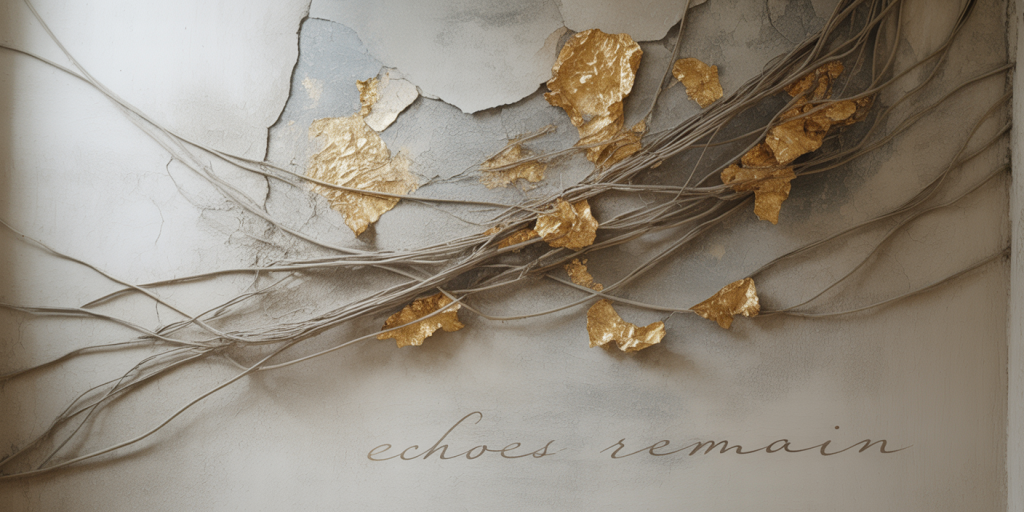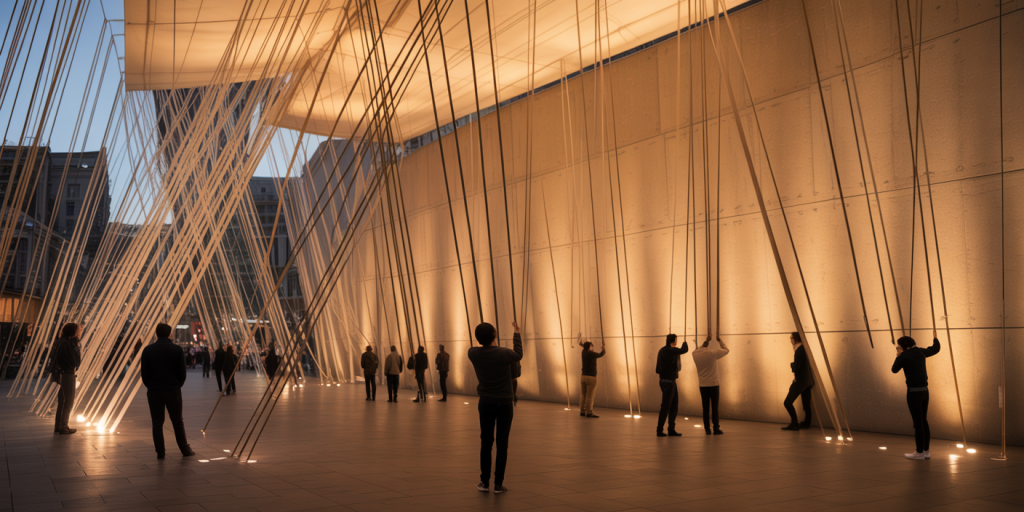When Lygia Pape Listened to the Walls Speak
As twilight settles over a city corner long forgotten, a wall exhales the secrets of a thousand footsteps. The concrete sighs, stained with time and whispering with color, and from this murmuring stone rises the voice of Lygia Pape. Her art is not just seen, but heard, inhaled, brushed against with the skin of memory. Her work pulses with the breath of place, each line drawn like a heartbeat echoing through plaster. She was never simply creating; she was translating the murmurs of lived matter into poetic form.
It is within these muted thresholds, those surfaces worn by silence and shadows, that Pape opened the senses. She did not just observe the wall—she tuned herself to it, felt its vibrations, extracted its stories. Her process was one of intimacy, and her aesthetic, a choreography of whispers.

Table of Contents
- The Wall as Oracle
- Listening with the Eyes
- Textures Etched in Silence
- Geometry of the Invisible
- Gold That Breathes
- Voices in Black and White
- A Cartography of Shadows
- Haptic Dialogues
- The Wall as Flesh
- Echoes of the Favela
- Lines That Cut the Wind
- Poetry of Negative Space
- Memory as Pigment
- The Alchemy of Materials
- Sounds Made Solid
- The-Wall Between Subject and World
- Residue and Revelation
- Urban Palimpsest
- When Matter Becomes Voice
- Final Frequencies
The Wall as Oracle
Pape approached walls not as surfaces, but as oracles. She believed they held messages accumulated over time, like layers of sedimentary truth. A chipped fragment, a splatter of paint, a rusted wire—each detail became an inscription.
In her hands, the wall was an instrument played by human existence. She transformed neglected textures into sacred texts, revealing how urban scars could form a map to collective psyche.
Listening with the Eyes
To see was not enough. Pape urged us to listen visually. Her gaze was attuned to frequency and rhythm. She taught us to read vibrations, to perceive not only color but its hum, its heat, its memory.
Her mixed media works suspended silence, allowing it to shimmer. The viewer was invited to touch the atmosphere with the gaze, to extract sound from pigment.
Textures Etched in Silence
There is a tactile sorrow in the surfaces Pape touched. Her use of materials such as burnt wood, wire, cement, and silk was not incidental—it was confessional. These textures did not embellish but revealed.
The silence between forms, the intervals in texture, were as expressive as the marks themselves. It is within this quiet that her walls spoke loudest.

Geometry of the Invisible
Pape often engaged with geometry not as a system of precision, but as a language of the soul. Circles, lines, grids—they did not merely measure space; they composed affect.
Her Neoconcrete roots surface here, where geometry becomes lyrical, expressive. Shapes floated like breath against the wall, articulating the unspeakable.
Gold That Breathes
In her Tecelares series, the use of gold leaf and burnished surfaces did not signify opulence, but rather radiance. Gold was not a symbol of wealth, but of energy, breath, presence.
Placed upon woodblocks and prints, it seemed to pulse with light. The gold inhaled shadows and exhaled reverence, making even voids luminous.
Voices in Black and White
Printmaking was Pape’s poetry. Black and white were not opposites in her hands, but complementary voices. Negative space did not represent absence, but a counter-utterance.
Through contrast, she carved meaning. Her monochrome works radiated with multiplicity, each tone a different frequency of silence.
A Cartography of Shadows
Every wall in her oeuvre casts more than shadow—it casts memory. Light and shade, in her composition, do not simply indicate time of day, but state of being.
Her manipulation of light created maps of presence. Shadows became pathways, and their intersections, junctions of emotional geography.
Haptic Dialogues
Pape’s relationship with matter was sensual. Her work is always inviting the hand, even when untouchable. One feels the fibers of woodblock, the rough kiss of concrete.
This tactile intensity became her dialogue with the viewer. You do not merely see a Pape; you are seduced into skin-to-surface communion.
The Wall as Flesh
Walls for Pape were epidermal. They bled, bruised, wrinkled. They aged. She treated the wall not as backdrop but as skin—one capable of scar, of blush, of sweat.
It is this treatment that renders her work almost carnal. The physicality is human, the abstraction always rooted in the corporeal.
Echoes of the Favela
Pape never distanced herself from her sociopolitical context. Her work listened to the walls of Brazil’s favelas. Graffiti, grime, patchwork repairs—all became symbolic inscriptions.
These walls spoke of resilience, of struggle, of overlooked beauty. Her art gave voice to spaces historically silenced.
Lines That Cut the Wind
In her performative pieces and installations, strings and wires sliced through air like drawn breath. These were not boundaries, but paths of motion and attention.
The air became a canvas, the viewer a participant. Her lines did not enclose; they revealed the dance of presence.
Poetry of Negative Space
Few artists embraced absence as presence the way Pape did. The unmarked, the skipped, the withheld—these were not voids but verses.
She taught us that silence is not the opposite of expression, but its partner. That negative space is not emptiness, but breath held.
Memory as Pigment
Much of Pape’s color was mnemonic. Ochres evoked sun-drenched stone, umbers the hush of dusk, whites the breath of laundry billowing over an alley.
Each hue in her work carried the burden of a remembered place. Her palette was not selected—it was summoned.
The Alchemy of Materials
Pape transmuted common materials into relics. Charcoal became illumination. String became speech. Cardboard became cathedral.
Her genius lay in this alchemy—the transformation of the discarded into the sacred. In her hands, trash became oration.
Sounds Made Solid
Even her installations vibrated with sonic presence. One felt echoes without echo, imagined resonance where there was none. A suspended piece hummed in silence.
These were not sound sculptures, but sculpted listening. Each component was a frozen echo, a moment of resonance hardened into presence.

The Wall Between Subject and World
Pape blurred the boundary between viewer and viewed. Her works dissolved the distinction between self and surface. One did not face her art; one entered it.
She sculpted thresholds, not objects. Her walls became portals of experience, inviting intimacy rather than observation.
Residue and Revelation
Smudges, creases, tears—Pape welcomed residue. These traces were not flaws but revelations. They marked encounter, process, time.
The imperfect was her grammar. The wall revealed not perfection but contact—a record of what had passed, of who had touched.
Urban Palimpsest
She treated the city as a palimpsest—a layered text of human action. Walls bore witness. She read their graffiti, posters, scratches as verse.
Pape scraped back layers, not to restore, but to reveal. Her work invites us to do the same with our cities, and ourselves.
When Matter Becomes Voice
Ultimately, her genius was in making matter speak. She made wood murmur, concrete confess, gold whisper. Her works are more vocal than visual.
She transformed the wall from silent witness to speaker. Through her, architecture sang.
Final Frequencies
There is no silence in Pape. Only listening. Her work demands a pause, a breath, an openness to frequency. She reminds us that walls are not inert—they record, they speak, they wait.
When we stand before her work, we do not just look. We listen. And in that listening, we become part of the echo.
FAQ
Who was Lygia Pape?
Lygia Pape (1927–2005) was a Brazilian artist associated with the Neoconcrete movement. She worked across mediums—printmaking, installation, performance, and film—exploring the interplay between material, body, and perception.
What is the Neoconcrete Movement?
Emerging in the late 1950s in Brazil, Neoconcretism rejected the rigid rationality of Concrete Art, seeking instead a more expressive, sensory, and participatory approach. It emphasized experience over object.
What does it mean to “listen to walls”?
This phrase, in the context of Pape’s work, refers to perceiving the histories, emotions, and resonances embedded in everyday materials and architectural surfaces. It is a metaphor for heightened sensory and symbolic awareness.
What materials did Pape use?
She worked with wood, string, gold leaf, paper, silk, charcoal, cement, and found objects, often combining them in installations that evoked tactile, sonic, and emotional responses.
How did Pape address social themes?
Her work often responded to Brazilian urban life, poverty, and the political repression of the dictatorship. She gave form to marginal voices through poetic materiality and spatial sensitivity.
What is her legacy?
Pape remains a foundational figure in Latin American art. Her blending of sensuality and structure, poetry and politics, continues to influence contemporary artists globally.
Final Notes: The Echoes Remain
Lygia Pape did not paint portraits or compose static views. She revealed acoustics. Her walls were tuned to the vibration of presence. She sculpted with breath, inscribed with silence, and gilded the invisible.
To witness her work is to learn how to hear again. To realize that the world around us is speaking in frequencies we have forgotten to notice. That a wall may be nothing more than a skin stretched over a city’s memory.
And so we return to that street corner, where a patch of sunlight trembles on cracked stucco. We place a hand against it. We listen.
It speaks.
